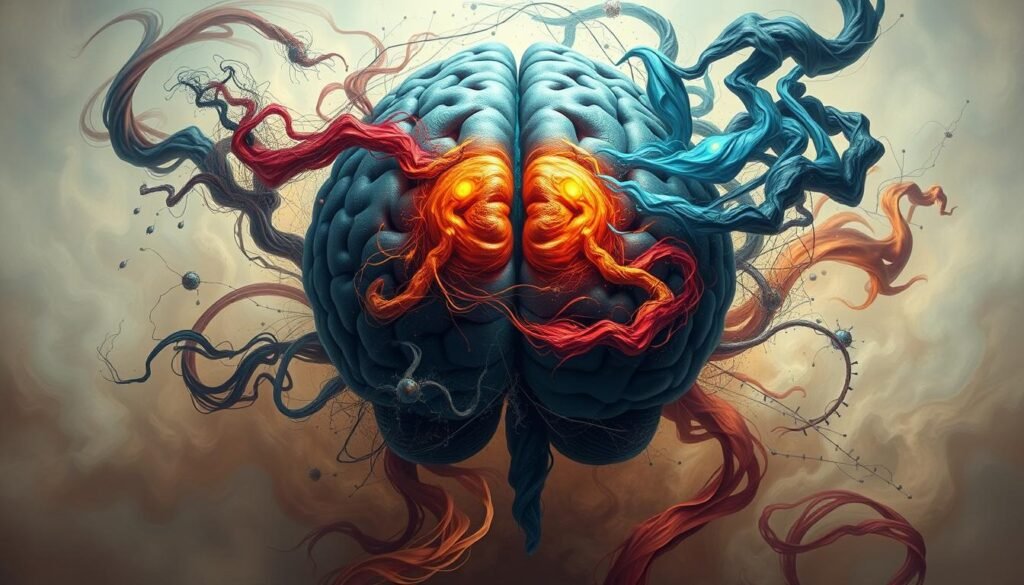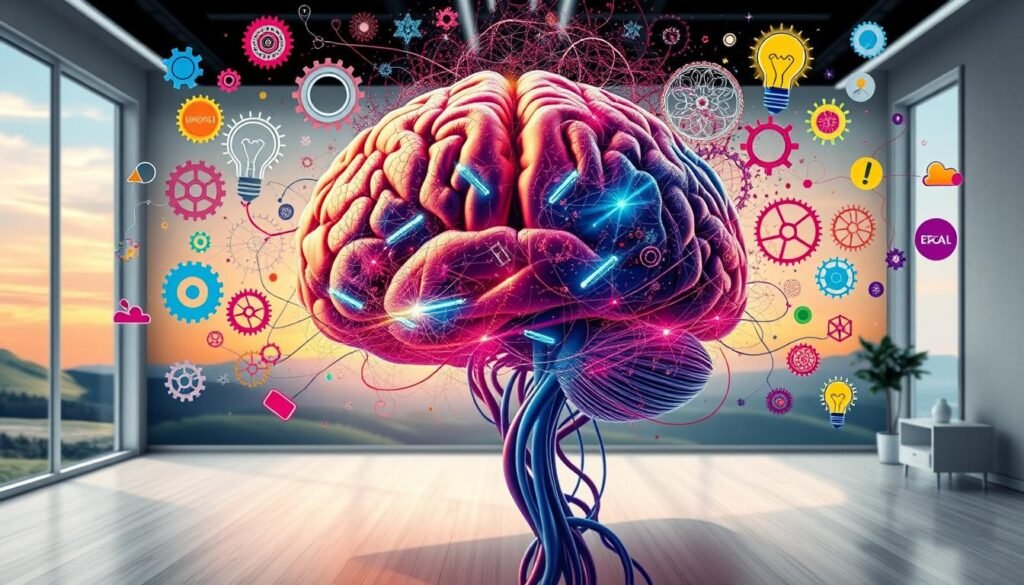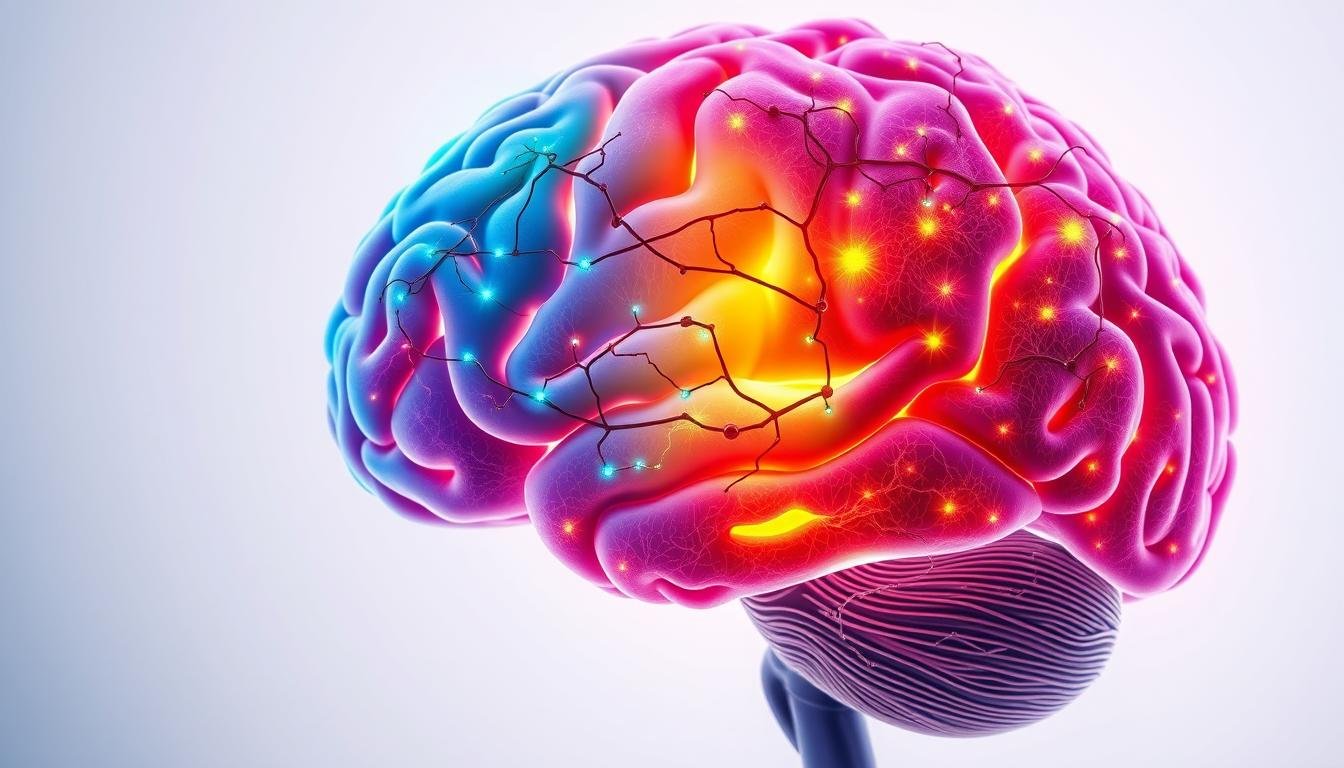Living with social anxiety can be tough, but knowing how it affects the brain helps. Studies show key brain areas like the amygdala and prefrontal cortex are vital. They help us deal with social interactions and emotions.
For those with social anxiety, the amygdala can be too active. This makes fear responses stronger. The prefrontal cortex, which helps us make decisions and control ourselves, is often less active and smaller. This makes it harder to handle our emotions.
Other brain areas, like the anterior cingulate cortex and fusiform gyrus, also change in people with social anxiety. These changes can make emotions feel more intense. They can also make it hard to read facial expressions and social cues.
Key Takeaways
- Social anxiety disorder is linked to changes in key brain areas like the amygdala, prefrontal cortex, and hippocampus.
- An overactive amygdala and underactive prefrontal cortex can cause intense fear and trouble with emotional control in social settings.
- Changes in the anterior cingulate cortex and fusiform gyrus can lead to stronger emotional reactions and trouble with social cues.
- Cognitive Behavioral Therapy (CBT) and medication can help tackle the brain changes of social anxiety and find ways to cope.
- Making lifestyle changes, building support systems, and getting professional help are key to managing social anxiety and improving brain health.
Understanding Social Anxiety Disorder: Basics and Definition
Social anxiety disorder, also known as social phobia, is a mental health issue. It makes people feel very anxious and self-conscious in social situations. They fear being judged or seen as wrong by others, which makes them avoid social events and feel a lot of distress.
Common Signs and Physical Symptoms
Those with social anxiety disorder often show physical signs like blushing, sweating, and trembling. They might also have a fast heartbeat, nausea, and worry a lot. They often want to get out of the situation they’re in.
Impact on Daily Life and Activities
Social anxiety disorder can really mess up someone’s life. It can make it hard to keep friends, do well at work or school, and enjoy activities. The fear of being around others can cause people to stay away from social events and have trouble making friends.
Risk Factors and Prevalence
Things like family history, bad experiences, and personality can lead to social anxiety disorder. It usually starts in the teens and is more common in women. Social anxiety disorder affects about 5% to 10% of people worldwide, making it a big mental health issue.
“Many individuals with social anxiety disorder do not seek help as they mistake the condition for just being part of their personality.”
Social Anxiety Affect the Brain: Neural Mechanisms
Understanding how social anxiety disorder (SAD) affects the brain is key to finding effective treatments. Studies using neuroimaging have shown that certain brain areas are crucial. These include the amygdala, prefrontal cortex, anterior cingulate cortex, fusiform gyrus, and hippocampus.
The amygdala is a key part of the brain that deals with emotions and fear. It’s been found to be more active in people with SAD. Studies using fMRI have shown that people with SAD have a more sensitive fear response to both social and non-social stimuli.
The prefrontal cortex helps control emotions. In people with anxiety, it’s less connected to the amygdala. This makes it harder to manage fear and anxiety.
The hippocampus helps the amygdala process signals and is involved in forming emotional associations. It’s linked to holding onto fear memories in SAD. This can lead to avoiding social situations.
Studies have also found abnormalities in the anterior cingulate cortex, fusiform gyrus, and other brain regions. These areas are important for social cognition, emotional processing, and fear regulation. This shows how complex social anxiety disorder is at a neural level.
By knowing which brain regions are involved in social anxiety, researchers and clinicians can create better treatments. These treatments aim to fix the underlying neural circuits. This can help people with social anxiety disorder manage their symptoms better.
| Brain Region | Role in Social Anxiety |
|---|---|
| Amygdala | Processes emotions and fear responses; exhibits heightened activity in individuals with social anxiety disorder. |
| Prefrontal Cortex | Responsible for emotional regulation; shows weaker connectivity with the amygdala in those with anxiety disorders. |
| Hippocampus | Processes signals from the amygdala and is involved in forming associations between emotions and objects; linked to the retention of fear memories in social anxiety disorder. |
| Anterior Cingulate Cortex | Exhibits abnormalities in individuals with social anxiety disorder, impacting social cognition and emotional processing. |
| Fusiform Gyrus | Abnormalities in this region, involved in face processing, have been observed in those with social anxiety disorder. |
“By understanding the brain regions involved in social anxiety, researchers and clinicians can develop more targeted therapeutic interventions to address the underlying neural circuits and ultimately help individuals with social anxiety disorder manage their symptoms more effectively.”
The Role of Amygdala in Social Anxiety
The amygdala is a small almond-shaped part of the brain. It’s key in handling emotions like fear and anxiety. For people with social anxiety, research shows their amygdala works too hard when they’re around others.
Amygdala Size and Activity Patterns
Studies have found that people with social anxiety have a bigger amygdala. The size of their amygdala often matches how bad their symptoms are. This means their amygdala is too active, causing them to feel scared, worried, and uncomfortable around others.
Fear Response and Emotional Processing
The amygdala starts the “fight-or-flight” response. This can cause physical signs like a fast heartbeat, sweating, and shaking. This strong fear response makes it hard for those with social anxiety to control their feelings and feel at ease with others.
Connection to Other Brain Regions
The amygdala also links with other brain areas, like the prefrontal cortex. This area helps control emotions. But in social anxiety, these connections are messed up. This makes it even harder for them to handle their feelings in social situations.
Knowing how the amygdala affects social anxiety is key. It helps us create better treatments. These treatments aim to help people with social anxiety manage their symptoms and live better lives.
Prefrontal Cortex and Emotional Regulation
The prefrontal cortex (PFC) is key for planning, decision-making, and controlling emotions. In people with social anxiety, the PFC is less active and smaller. This makes it hard for the PFC to talk to other brain parts, like the amygdala, which handles fear and anxiety.
For those with social anxiety, the PFC actually makes the amygdala work harder during social events. This means they feel more fear and anxiety. It’s tough for them to keep their emotions in check.
Studies show that people with social anxiety use different thinking patterns and brain activity in social situations. They might find it hard to judge threats, use strategies to calm down, and deal with physical symptoms of anxiety.
| Brain Region | Role in Social Anxiety |
|---|---|
| Prefrontal Cortex (PFC) | Typically underactive and smaller in size, disrupting communication with the amygdala and leading to heightened fear and anxiety responses. |
| Amygdala | Responsible for processing fear and anxiety, which is often overactive in individuals with social anxiety disorder due to the disrupted communication with the PFC. |
It’s important to understand the PFC’s role in social anxiety to find better treatments. By working on the PFC, we can help people with social anxiety manage their feelings better. This can greatly improve their lives.

“The PFC plays a crucial role in predicting the likelihood of threats in the environment, engaging in high-level strategies to regulate anxiety-associated responses, and can be linked to core symptoms associated with anxiety disorders.”
Brain Chemistry and Neurotransmitter Imbalances
Neurotransmitter imbalances are key in social anxiety disorder. Serotonin, important for mood, is often low in those with social anxiety. This can make them more fearful and struggle with social interactions.
Stress hormones like cortisol and adrenaline are also high. These can cause symptoms like a fast heartbeat, sweating, and tense muscles. These symptoms make social situations even more stressful.
Serotonin’s Role in Social Anxiety
Serotonin helps control mood, sleep, and appetite. Low levels are linked to more anxiety, including social anxiety disorder. Medications like SSRIs can help manage symptoms by targeting serotonin.
Impact of Stress Hormones
People with social anxiety have higher stress hormones. These hormones make the body ready to fight or flee. This can make anxiety worse in social situations. Finding ways to manage stress is key to addressing these imbalances.
Oxytocin and Social Behavior
Oxytocin, known as the “love hormone,” helps with social bonding and reduces anxiety. Those with social anxiety might have lower oxytocin levels. This could make it hard to connect with others. Boosting oxytocin levels might help with social challenges.
In summary, social anxiety disorder involves complex brain chemistry and neurotransmitter imbalances. Serotonin, stress hormones, and oxytocin play roles. Understanding these can help in managing and treating the disorder.
Cognitive Behavioral Therapy and Brain Plasticity
Cognitive Behavioral Therapy (CBT) is a proven treatment for social anxiety disorder. It changes brain activity, especially in the amygdala and prefrontal cortex. These areas are key to social anxiety.
CBT helps people change their negative thoughts and behaviors. This shows the brain’s ability to adapt and make new connections. It’s called neuroplasticity. By focusing on the core issues of social anxiety, CBT can change the brain’s structure and function.
Research shows CBT reduces amygdala volume and sensitivity in people with social anxiety. This leads to fewer symptoms. CBT for depression also improves brain connections and activity, reducing fear responses.
CBT is different from antidepressants because it offers long-term solutions. It reshapes the brain’s structure and function. Unlike some medications, CBT is shorter, lasting weeks or months. It teaches people practical skills to manage their anxiety.
The Lukin Center is a leading provider of CBT. It helps improve mental health by changing thoughts and behaviors. CBT uses the brain’s plasticity to help people achieve their goals and regain confidence.

“Cognitive Behavioral Therapy can induce lasting changes in brain structure and function, demonstrating the remarkable plasticity of the human brain.”
The connection between cognitive behavioral therapy for social anxiety, neuroplasticity, and psychotherapy is promising. It offers hope for those looking for lasting solutions to social anxiety.
Medication Options and Their Effects on Brain Function
Managing social anxiety disorder often involves medication. These treatments target the brain’s functions affected by the condition. Different medications work in various ways to help.
SSRIs are a common first choice for treating social anxiety. They increase serotonin levels in the brain. This helps manage mood and anxiety symptoms. Examples include fluoxetine, sertraline, and paroxetine.
SNRIs, like venlafaxine and duloxetine, also help. They affect both serotonin and norepinephrine. These neurotransmitters are key to mood and anxiety.
| Medication | Typical Dosage Range | Mechanism of Action |
|---|---|---|
| Fluoxetine (Prozac) | 20–60 mg once daily | SSRI |
| Sertraline (Zoloft) | 50–200 mg once daily | SSRI |
| Paroxetine (Paxil) | 20–60 mg per day | SSRI |
| Citalopram (Celexa) | 20–40 mg once daily | SSRI |
| Escitalopram (Lexapro) | 10–20 mg once daily | SSRI |
| Venlafaxine (Effexor) | 75–225 mg per day | SNRI |
| Duloxetine (Cymbalta) | 60–120 mg per day | SNRI |
These medications may take 4-8 weeks to fully work. Some people might experience side effects like nausea or headaches. Working closely with a healthcare provider is key to finding the right treatment.
Beta-blockers and benzodiazepines can also help with physical symptoms. But, they’re meant for short-term use due to risks of dependence.
Choosing the right medication for social anxiety depends on many factors. A healthcare provider will work with the patient to find the best treatment. The goal is to improve brain function and quality of life.
Natural Ways to Manage Social Anxiety
Medication and therapy can help with social anxiety disorder. But, we can also try natural ways to improve our brain health and well-being. Mindfulness, meditation, lifestyle changes, and strong support systems can help us manage social anxiety and live better lives.
Mindfulness and Meditation Practices
Mindfulness-based interventions, like the 8-week MBSR program, can be as good as antidepressants for anxiety. They help us stay in the moment and accept our thoughts and feelings. This way, we can better handle our anxiety and improve our emotional control.
Lifestyle Changes for Brain Health
A healthy lifestyle greatly affects our brain and anxiety levels. Regular exercise, especially aerobic activities, helps manage anxiety, as studies show. Also, enough sleep, less caffeine and alcohol, and a balanced diet improve brain health and reduce anxiety.
Support Systems and Social Connections
Having strong support systems and making social connections helps manage social anxiety. Support groups offer advice and help us feel less alone. By facing social situations and using coping strategies, we build confidence and overcome social anxiety.
FAQ
How does social anxiety affect the brain?
Social anxiety disorder changes brain areas like the amygdala and prefrontal cortex. These areas handle emotions, social cues, and fear. People with social anxiety show different activity and structure in these brain regions.
What is the role of the amygdala in social anxiety?
The amygdala deals with fear and anxiety. It’s key in social anxiety. Studies show it’s too active in social situations for those with social anxiety. It’s also slightly bigger, which links to how severe the symptoms are.
How does the prefrontal cortex contribute to social anxiety?
The prefrontal cortex, or PFC, is involved in planning and self-control. In social anxiety, it’s less active and smaller. This disrupts communication with the amygdala, leading to more fear and anxiety.
What neurotransmitter imbalances are associated with social anxiety?
Social anxiety is linked to imbalances in neurotransmitters. This includes low serotonin, high stress hormones like cortisol, and possibly lower oxytocin. These changes affect mood, physical responses, and social behavior.
How can Cognitive Behavioral Therapy (CBT) impact the brain in social anxiety?
CBT can change brain activity, especially in the amygdala and prefrontal cortex. It helps change negative thoughts and behaviors linked to social anxiety. This shows the brain can adapt and form new connections with therapy.
What medication options are available for treating social anxiety, and how do they affect the brain?
Treatments for social anxiety include SSRIs, SNRIs, beta-blockers, and benzodiazepines. These medications change brain chemistry and neurotransmitter levels. They can increase serotonin or block adrenaline effects.
What natural approaches can help manage social anxiety?
Natural ways to manage social anxiety include mindfulness and meditation. They reduce anxiety and improve emotional control. Regular exercise, good sleep, and a healthy diet also help brain health and anxiety. Building a strong support system and gradually increasing social connections can also help.
